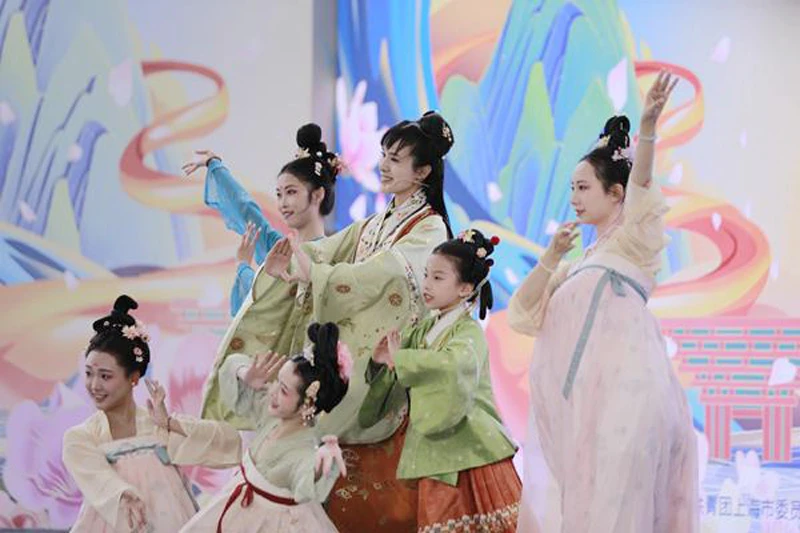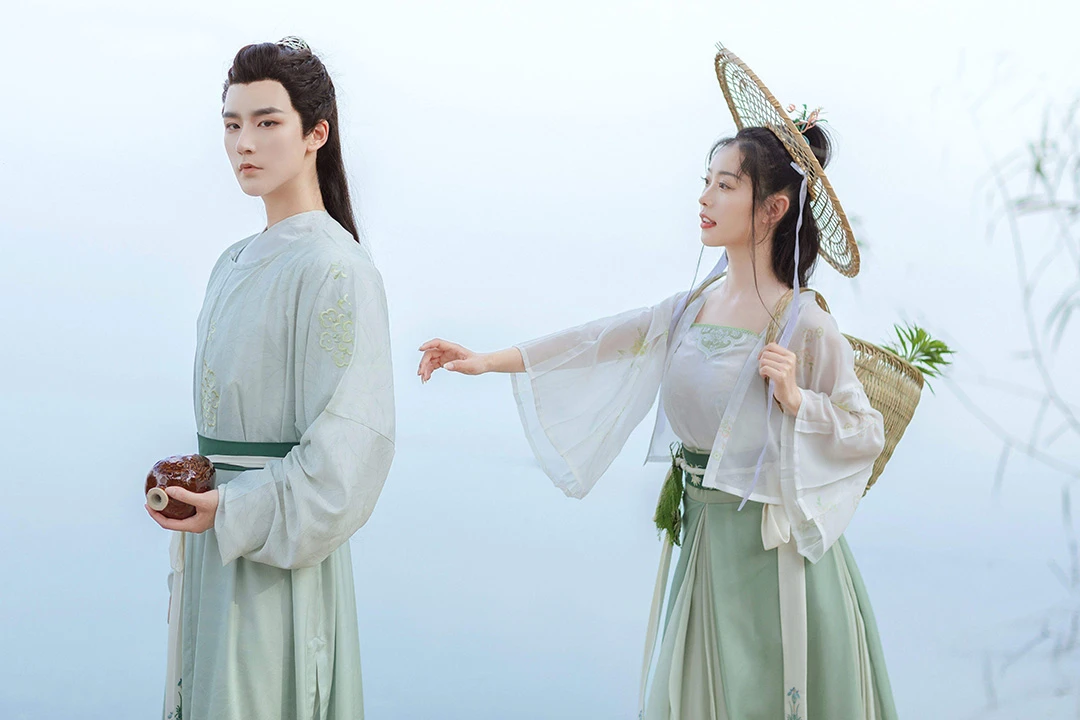Where the depth of spring resides, the Sanguan Festival finds its home. Recently, Shanghai welcomed a lively and grand “spring rendezvous” – the 2024 “Chinese Hanfu Week: Blossoming in Shanghai” series of events. Adorned in traditional Chinese attire (Hanfu), young people from across the nation converged at the Shanghai World Expo Park, strolling amidst a sea of blossoms, lingering by the winding streams, witnessing the graceful sway of Hanfu, appreciating poetry and songs, and savoring the essence of the quatrain arts. The renowned traditional culture promoter, Sister Xiaoyi, danced and sang, composing and performing the original Hanfu-themed song “The Song of Chinese Hanfu,” which made its nationwide debut under the “Crown of the Orient” in the China Pavilion.
“Chinese Hanfu, exuding dignity and vigor, donning the resplendent Chinese attire, invigorating the nation of etiquette…” Following the melodious tune, Sister Xiaoyi and her daughter “Little Tuanzi” graced the stage in the elegant Ming-style robes, expressing their adoration for Hanfu through song. “While performing the original Hanfu-themed song ‘The Song of Chinese Hanfu,’ I was continuously envisioning the glorious scenes of Hanfu’s thousand-year evolution,” Sister Xiaoyi reminisced. “Being able to convey my profound affection for Hanfu, my boundless love for the Chinese nation, and my deep resonance with the sentiment of patriotism through my singing and gestures fills me with immense honor as a promoter and inheritor of traditional culture.”
Reminiscing about her journey into the world of Hanfu, Sister Xiaoyi recalled her initial encounter. “The first time I saw Hanfu, I was captivated by the myriad styles and diverse elegance, igniting an infinite curiosity and imagination. The graceful etiquette and profound culture behind Hanfu made me fall in love with it from the very first sight.”
“I hope this song will immerse people in the 5,000-year-old Hanfu culture’s civilization and fragrance,” said Lian Xiangxian, a member of the Chinese Musicians Association, an executive member of the Guangdong Musicians Association, and the composer of “The Song of Chinese Hanfu.” In composing the piece, he focused on crafting a melody that is both grandly stirring and elegantly beautiful, while seamlessly blending the distinctive national instruments like the guqin and pipa with a Western symphony orchestra, creating an effect that is both traditional and fashionable, classical and modern. “I look forward to this song’s profound Chinese style being embraced and appreciated by more young people, transcending boundaries.”
Complementing the overall musical style, Sister Xiaoyi chose poetic and classical language for the lyrics. She explained, “Phrases like ‘radiant and vibrant’ and ‘graceful yet unrestrained’ showcase the unique charm and style embodied by Hanfu. ‘Traversing ancient and modern realms, evoking the enduring affection for the Chinese nation’ expresses reverence for Chinese history and the inheritance of traditional culture. ‘Brimming with joy, overflowing with auspiciousness and happiness’ conveys a love for life and well-wishes for the future. ‘Dignified and resolute, shouldering noble responsibilities’ reflects the confidence and sense of duty of those who wear Hanfu.”
In Sister Xiaoyi’s view, donning Hanfu is not merely a celebration of a festival but a vivid and tangible expression of love for Chinese culture and pride in the nation. “As the lyrics in ‘The Song of Chinese Hanfu’ sing, ‘Donning the resplendent Chinese attire, invigorating the nation of etiquette.’ Wearing Hanfu is an act of promotion and inheritance. In my heart, wearing Hanfu is a tribute to traditional culture. Through short video creations, I use poetry as the central thread, Hanfu as the vessel, and culture as the core, showcasing the beauty of Hanfu and the beauty of culture to everyone. Traditional culture is our foundation. I believe that the contemporary youth’s love for Hanfu is a manifestation of this cultural confidence and foundation. It allows us to maintain our cultural distinctiveness amidst the tide of globalization and preserve our cultural roots.”
Many fellow Hanfu enthusiasts at the event also expressed their fondness for the song, unconsciously humming along to the rhythm. “The Song of Chinese Hanfu” is not merely a tribute to Hanfu but a salute to the Hanfu lovers who have silently dedicated themselves to the revival of this tradition. At the moment they chose to wear Hanfu, these “fellow Hanfu enthusiasts” assumed a new role – interpreters and promoters of China’s outstanding traditional culture.
“With unwavering passion, we inherit and develop the Hanfu culture. With each rendition of this song, I believe everyone will feel an even greater sense of strength and enthusiasm. The beauty of Hanfu lies in its historical sedimentation, its cultural connotations, and most importantly, the sentiment of patriotism it represents. ‘Pursuing the dream of our nation, residing in the heart of China’ – Chinese civilization has a long and profound history. I sincerely hope more people will come to appreciate Hanfu and China’s outstanding traditional culture. In the future, I will continue to innovate in terms of content and form, joining hands with everyone to make our modest contribution in revitalizing China’s outstanding traditional culture through innovative means,” Sister Xiaoyi said with anticipation.
The radiant charm of Hanfu has captured the hearts of many, transcending age and background. Among the attendees was a mother-daughter pair, both adorned in elegant Hanfu robes. The mother, Mrs. Wang, beamed as she watched her 8-year-old daughter Xiaohua twirl gracefully. “Wearing Hanfu instills in Xiaohua a sense of cultural identity and appreciation from a young age. It’s a way for her to connect with her roots and heritage.”
Xiaohua’s eyes sparkled as she smoothed the intricate embroidery on her robe. “I feel like a princess from ancient times!” she exclaimed. “The colors and patterns are so beautiful. I love learning about the stories and meanings behind each design.”
For many, Hanfu represents more than just traditional attire – it is a canvas that depicts the rich tapestry of Chinese civilization. Calligrapher Zhang Wei ran his fingers over the silk fabric, marveling at the craftsmanship. “Each stitch is a thread in the narrative of our history,” he mused. “By wearing Hanfu, we become living embodiments of that narrative, carrying forward the cultural legacy.”
The event was a convergence of artistry and heritage, with various Hanfu-inspired displays and performances. Visitors could witness skilled embroiderers meticulously stitching intricate patterns, or marvel at the graceful movements of dancers in flowing Hanfu robes. Calligraphers showcased their mastery, using brushes to breathe life into ancient proverbs and poetic verses adorning the garments.
For many young attendees, Hanfu represents a reclamation of cultural identity in an increasingly globalized world. University student Liang Mei spoke passionately about her love for Hanfu. “In a world that often prioritizes homogeneity, Hanfu allows us to celebrate our uniqueness and our roots. It’s a tangible connection to the richness of our heritage.”
The event also highlighted the growing Hanfu community, where enthusiasts share tips on styling, discuss historical contexts, and support local artisans. Online platforms and social media have played a pivotal role in fostering this community, creating spaces for education, appreciation, and creativity.
As the event drew to a close, the echoes of “The Song of Chinese Hanfu” lingered in the air, a poignant reminder of the enduring spirit of Chinese culture. For many, the experience was not just a celebration of Hanfu but a reaffirmation of cultural pride and a commitment to preserving and promoting China’s ancient traditions for generations to come.
In the words of Sister Xiaoyi, the song’s creator, “Hanfu is not just clothing; it is a living embodiment of our nation’s soul. Through its revival, we honor our ancestors’ wisdom and ingenuity, while inspiring future generations to carry forth that sacred flame of cultural identity.”


